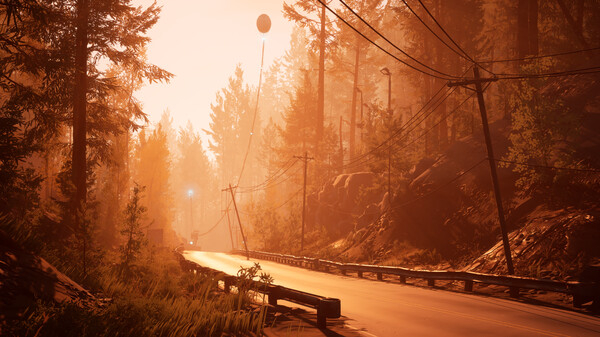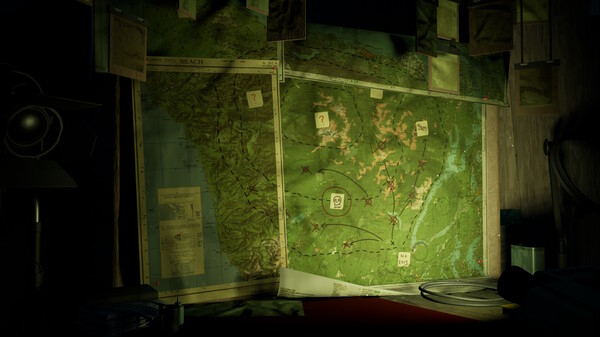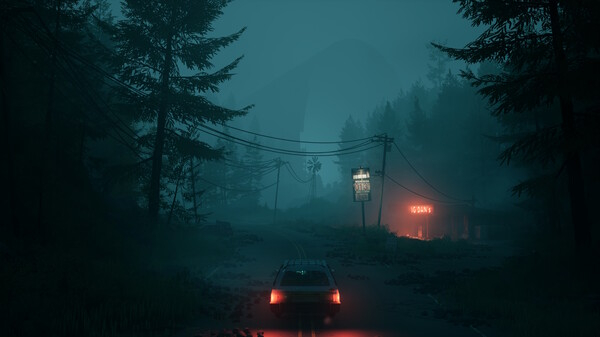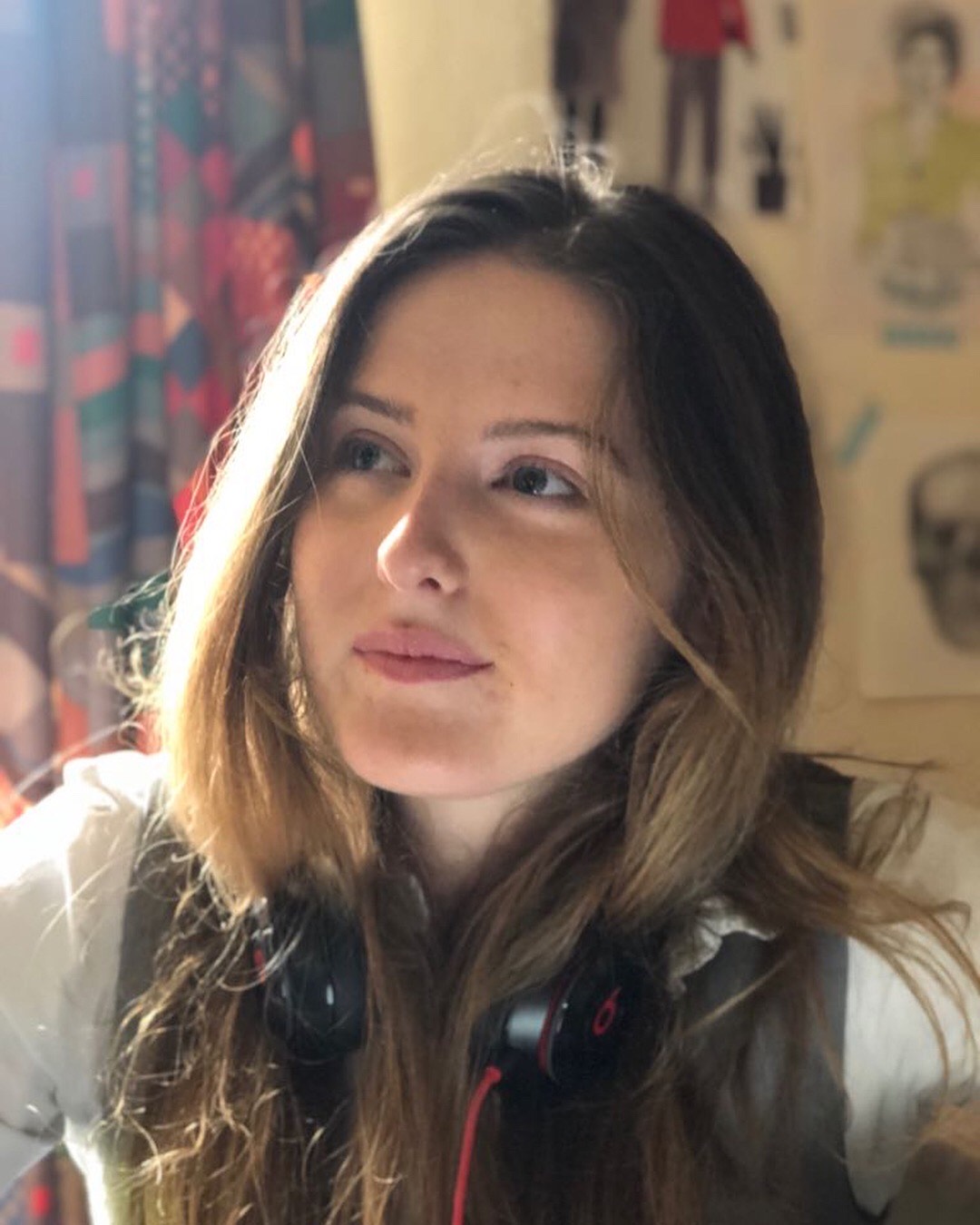A Shell in the Pit’s studio director talks us through Pacific Drive’s radio soundtrack and his song Ghost on the Road
More than just a song

“I don't get to play games very much; I have two kids under five, I run a studio, and I'm directing a game,” Gordon McGladdery, A Shell in the Pit’s studio director and singer/songwriter for Ghost on the Road, tells me. As a result, when it came to producing the first song in Pacific Drive’s radio soundtrack, he had to “go off vibes and trust direction for the most part." But that didn’t stop McGladdery from creating one of the best songs I’ve ever heard in a video game, as well as curating a soundtrack that goes above and beyond what I’d expected to find in a game like Pacific Drive.
The first time I heard Ghost on the Road in Pacific Drive, the new survival game from Ironwood Studios, was also when I got my first proper look at the Olympic Exclusion Zone, an area that players explore throughout the game. Driving through the dense pinewood forests under a night sky that shifted and swayed with absurd colors, I rounded a bend and saw the map in front of me open up just as Ghost on the Road kicked in. As the pine trees fell away, I saw the Exclusion Zone’s wall, dwarfing all that stood before it, including my humble station wagon.
Feelings of awe, insignificance, and dread washed over me as I stared at that gigantic wall, even before I knew what the Zone had in store for me. It was a perfect start to a survival game and something that wouldn’t have been so impactful if Ghost on the Road was just another throwaway song.
Highway 16

“That song means a lot to me,” McGladdery explains. “I worked really hard on it. I don't get the opportunity to write personal music anymore, and it was basically a commissioned personal song.”
Even though McGladdery had a fairly decent idea about what Pacific Drive was doing, as he’d been working on the radio soundtrack list before writing Ghost on the Road, he didn’t want to write a song that reflected what the player would go through. Instead, he took the opportunity to write about something that was closer to home but still fit in with Pacific Drive’s Dark Folk direction.
“I'm not thinking about the game in Ghost on the Road,” McGladdery says. “It's a similar theme, but it's about my hometown. It's about growing up on Highway 16 in Prince George, which has a very dark past, so it's a very personal song.”
“Highway 16, in Prince George, Canada, is known as the Highway of Tears. A lot of indigenous, mainly women, have gone missing along it over the years, dozens. And the authorities have failed them in finding justice. I grew up as a privileged kid in that town, and now, being older, it’s a different world. Ghost on the Road was a reflection on how little I knew about it growing up and how little we were told about what was happening. It's not a perfect metaphor; it's more of a feeling that was inspired by Highway 16.”
Sign up for breaking news, reviews, opinion, top tech deals, and more.
The Highway of Tears is a 447-mile stretch of Highway 16, which falls between Prince George and Prince Rupert in British Columbia, Canada. It gained its title due to the high rates of violence and crimes against women and girls, most of whom are indigenous. Since 1950, there have been 18 official cases of missing or murdered in the area, but unofficial counts from friends and family place the number at around 50 (via Al Jazeera).
McGladdery’s work didn’t just consist of creating Ghost on the Road; he also dedicated his time to coordinating the radio soundtrack release as well as helping with recommendations for other artists who would appear on the album, which would prove to be no easy task.
Multi-tasking to the max

There are 26 songs on Pacific Drive’s radio and almost all of these are from local musicians from the Pacific Northwest area, many of whom were friends of friends. “There’s a lot of very small artists, as well as several of the artists who don't even have anything on Spotify yet,” McGladdery says. “Their song on the album is the first song that they have in the world, basically, which I think is kind of rare.”
Finding the right songs for the radio’s soundtrack was a very selective process and one that McGladdery and Ironwood Studios creative director Alexander Dracott took very seriously. “Almost all of the bands are from the greater Pacific Northwest Area,” Dracott tells me. “The process mostly just involved listening to thousands and thousands of songs.”
I talked with every band, or every artist that was in the game. I met with them and explained Pacific Drive: what the game is, here's what you should expect, here's why we're interested. It was a blast, but it definitely was a lot of work.”
“My favorite is Swansea, by Lemolo,” McGladdery says. “I heard that one, and I kind of held it up, and I was like, my song has to be produced as well as this one. Discovering Lemolo was fantastic because that entire album is incredible. So this game introduced me to one of my favorite artists of last year.”
Once the team found the right artists for the job, McGladdery took it upon himself to try and collate a proper playlist for Pacific Drive’s radio soundtrack so fans had a cohesive package and an easy way to discover and sift through all the amazing songs that would accompany players on their adventures in the Exclusion Zone.

“It's extremely difficult and so complicated to work with licensed music,” McGladdery explains. “It was so much more work than I expected. Finding a digital distributor that can handle or even just knows the answers to questions like: ‘Okay, so this artist has a label, and the song was released in 2014 already. If I release it again on this album, will it get bounced by the content ID algorithms?’
“I went through five or six different digital distributors, just trying to find one that could answer my questions before I landed on one that seemed confident. Then it's back and forth with 23 different artists and their labels getting permission to release a song again that they've already released, making sure that they know we're not taking advantage of them.”
Luckily, Ironwood Studios made everything as easy as possible as it wasn’t looking for exclusive rights; just the permission to play the songs in Pacific Drive and add them to the tracklist. But even so, there were a few close calls for McGladdery, especially towards the end of production.
“I got permission from a couple of artists who are more popular with labels, busy people, two days before I had to hit the button to get it out in time,” McGladdery recalls. “So it was a bit stressful.” That stress and hard work seemed to pay off. The soundtrack did get sorted in time, and I feel it added a level of depth that did wonders for Pacific Drive and its haunting atmosphere.
“My advice for making a great radio soundtrack is, and this is what Alex did as a director, you don't want people to make a song for your game,” McGladdery says. “Because I think that's how things can come up a bit cheesy. You just want people to make the best song that they can within the parameters of the genre given to them.”
Hard work pays off

McGladdery didn’t know that Ghost on the Road would end up being the first song played in the game and the first on the overall tracklist; he just set out to try and make a great song, something that he would want to listen to, and it turns out that it’s something that a lot more people wanted to listen to as well.
“People always tell you not to read the YouTube comments,” McGladdery says. “But the YouTube comments for Ghost on the Road are some of the nicest things anyone's ever said to me. It feels great; it's been very encouraging.”
Everybody writing music and artists in general just want to connect with people
Gordon McGladdery
A Shell in the Pit also worked tirelessly on Pacific Drive’s SFX, noises for the anomalies, and general ambient sound. "I always felt like designing for Pacific Drive was designing sci-fi SFX with strange organic elements,” Jamie Lee, a sound designer at A Shell in the Pit, explained. “Friendly resource providers have more ‘friendly’ textures, overtones, and cadences, and things that are dangerous have something unsettling about them. For those, I used uncomfortable intervals and overtones and some sneaky irregular pulses. The storm's incoming sound is an example of it!"
Pacific Drive was released on February 22, 2024, for PlayStation 5 and PC, and has garnered some fantastic support so far. In TechRadar Gaming’s review, we discussed how the crafting system, thrilling action sequences, beautiful soundtrack, and ambient noises make it a survival game that’s very hard to put down. The full soundtrack is also available to listen to on Spotify or Apple Music for all to enjoy and experience, regardless of whether you're washing some dishes or driving your station wagon off a cliff in the Olympic Exclusion Zone.
“Everybody writing music and artists in general just want to connect with people, and when that connection is verified, it’s a good feeling,” McGladdery reflects. Ghost on the Road does this with little to no effort. It never failed to make my experience in the Exclusion Zone better and has even now shifted over to my regular Spotify playlist. I still think about that initial drive through the pinewoods of Pacific Drive with this song playing in the background and the shivers it sent down my spine.
For more excellent games be sure to check out the best survival games and the best story games available to play right now.

Elie is a Features Writer for TechRadar Gaming, here to write about anything new or slightly weird. Before writing for TRG, Elie studied for a Masters at Cardiff University JOMEC in International Journalism and Documentaries – spending their free time filming short docs or editing the gaming section for their student publications.
Elie’s first step into gaming was through Pokémon but they've taken the natural next step in the horror genre. Any and every game that would keep you up at night is on their list to play - despite the fact that one of Elie’s biggest fears is being chased.